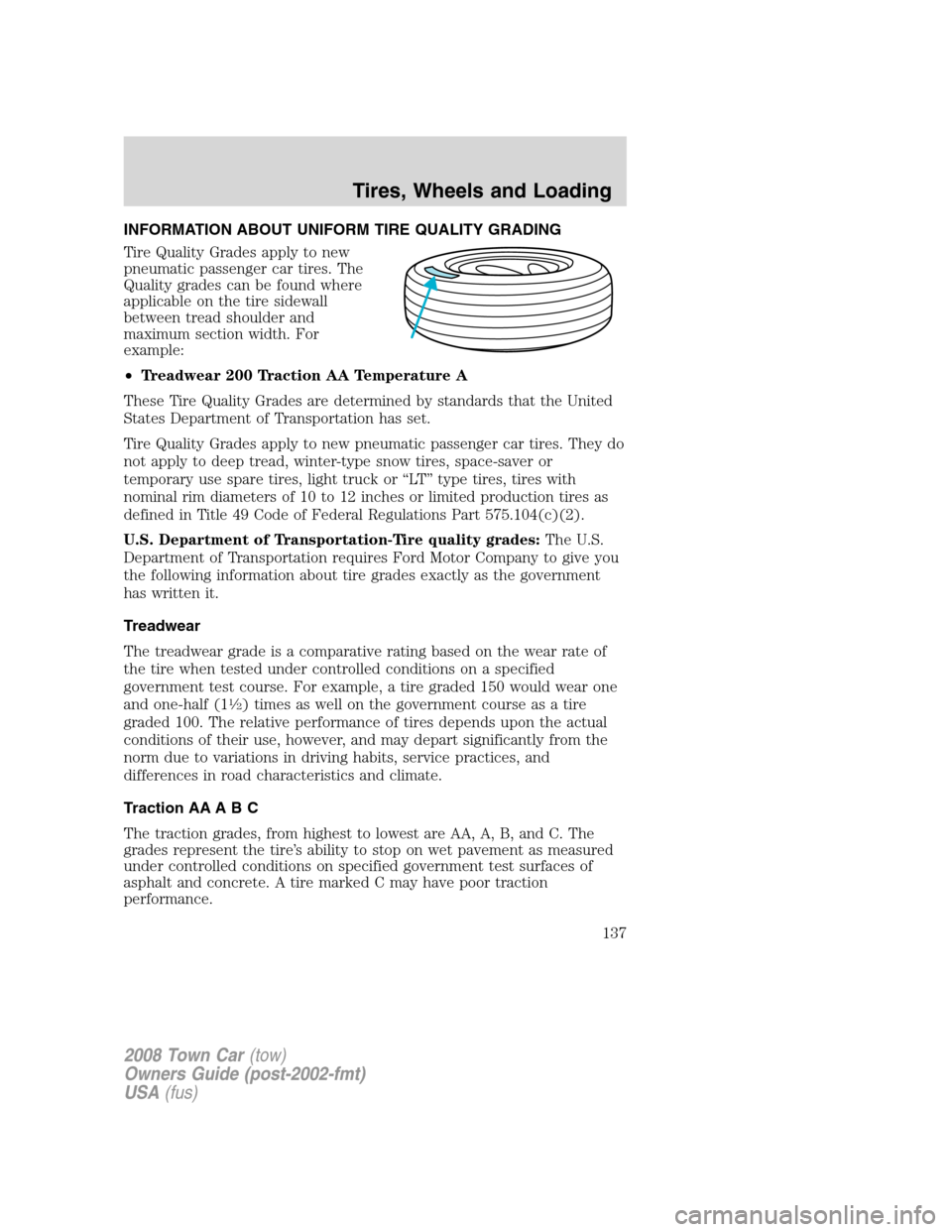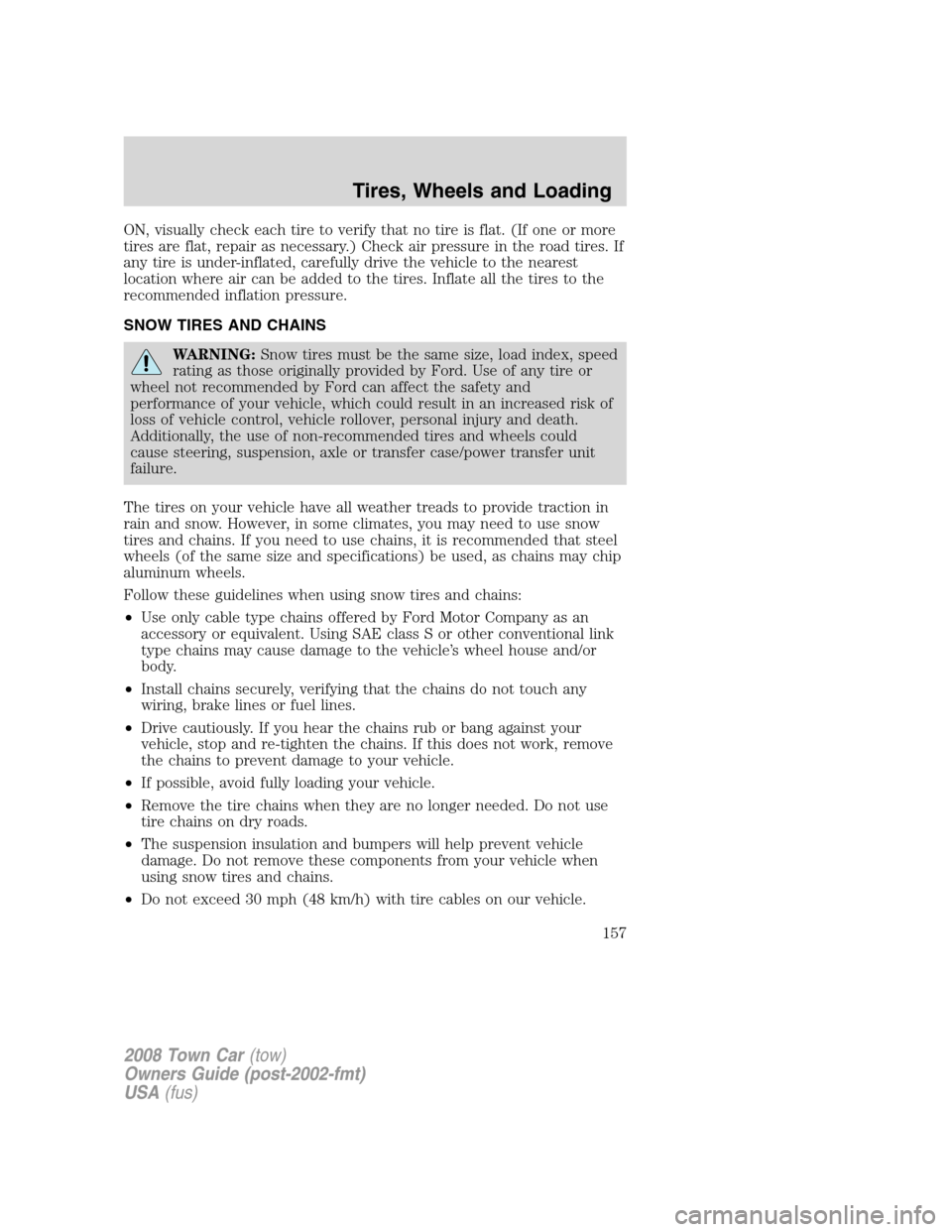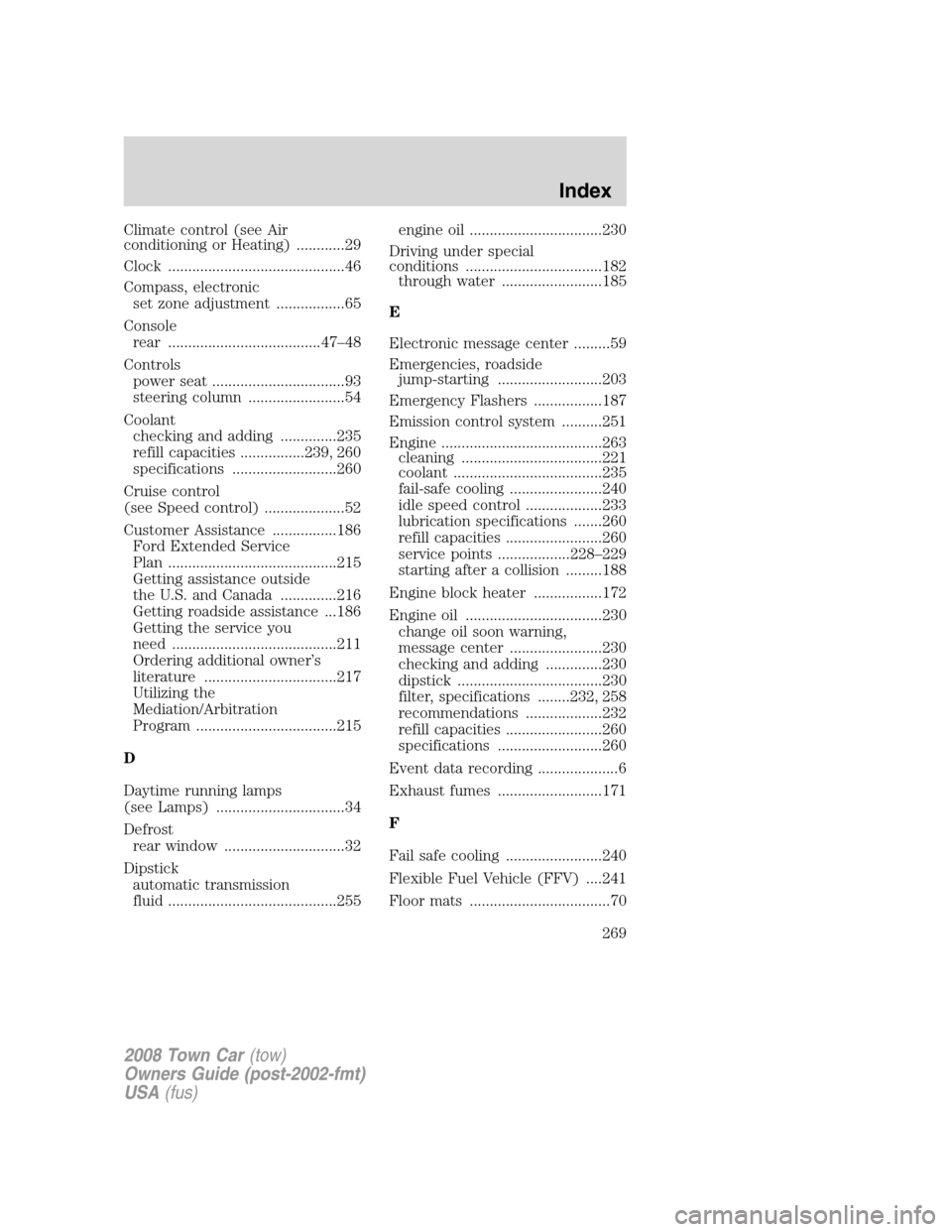Page 137 of 273

INFORMATION ABOUT UNIFORM TIRE QUALITY GRADING
Tire Quality Grades apply to new
pneumatic passenger car tires. The
Quality grades can be found where
applicable on the tire sidewall
between tread shoulder and
maximum section width. For
example:
•Treadwear 200 Traction AA Temperature A
These Tire Quality Grades are determined by standards that the United
States Department of Transportation has set.
Tire Quality Grades apply to new pneumatic passenger car tires. They do
not apply to deep tread, winter-type snow tires, space-saver or
temporary use spare tires, light truck or “LT” type tires, tires with
nominal rim diameters of 10 to 12 inches or limited production tires as
defined in Title 49 Code of Federal Regulations Part 575.104(c)(2).
U.S. Department of Transportation-Tire quality grades:The U.S.
Department of Transportation requires Ford Motor Company to give you
the following information about tire grades exactly as the government
has written it.
Treadwear
The treadwear grade is a comparative rating based on the wear rate of
the tire when tested under controlled conditions on a specified
government test course. For example, a tire graded 150 would wear one
and one-half (1
1�2) times as well on the government course as a tire
graded 100. The relative performance of tires depends upon the actual
conditions of their use, however, and may depart significantly from the
norm due to variations in driving habits, service practices, and
differences in road characteristics and climate.
Traction AA A B C
The traction grades, from highest to lowest are AA, A, B, and C. The
grades represent the tire’s ability to stop on wet pavement as measured
under controlled conditions on specified government test surfaces of
asphalt and concrete. A tire marked C may have poor traction
performance.
2008 Town Car(tow)
Owners Guide (post-2002-fmt)
USA(fus)
Tires, Wheels and Loading
137
Page 157 of 273

ON, visually check each tire to verify that no tire is flat. (If one or more
tires are flat, repair as necessary.) Check air pressure in the road tires. If
any tire is under-inflated, carefully drive the vehicle to the nearest
location where air can be added to the tires. Inflate all the tires to the
recommended inflation pressure.
SNOW TIRES AND CHAINS
WARNING:Snow tires must be the same size, load index, speed
rating as those originally provided by Ford. Use of any tire or
wheel not recommended by Ford can affect the safety and
performance of your vehicle, which could result in an increased risk of
loss of vehicle control, vehicle rollover, personal injury and death.
Additionally, the use of non-recommended tires and wheels could
cause steering, suspension, axle or transfer case/power transfer unit
failure.
The tires on your vehicle have all weather treads to provide traction in
rain and snow. However, in some climates, you may need to use snow
tires and chains. If you need to use chains, it is recommended that steel
wheels (of the same size and specifications) be used, as chains may chip
aluminum wheels.
Follow these guidelines when using snow tires and chains:
•Use only cable type chains offered by Ford Motor Company as an
accessory or equivalent. Using SAE class S or other conventional link
type chains may cause damage to the vehicle’s wheel house and/or
body.
•Install chains securely, verifying that the chains do not touch any
wiring, brake lines or fuel lines.
•Drive cautiously. If you hear the chains rub or bang against your
vehicle, stop and re-tighten the chains. If this does not work, remove
the chains to prevent damage to your vehicle.
•If possible, avoid fully loading your vehicle.
•Remove the tire chains when they are no longer needed. Do not use
tire chains on dry roads.
•The suspension insulation and bumpers will help prevent vehicle
damage. Do not remove these components from your vehicle when
using snow tires and chains.
•Do not exceed 30 mph (48 km/h) with tire cables on our vehicle.
2008 Town Car(tow)
Owners Guide (post-2002-fmt)
USA(fus)
Tires, Wheels and Loading
157
Page 269 of 273

Climate control (see Air
conditioning or Heating) ............29
Clock ............................................46
Compass, electronic
set zone adjustment .................65
Console
rear ......................................47–48
Controls
power seat .................................93
steering column ........................54
Coolant
checking and adding ..............235
refill capacities ................239, 260
specifications ..........................260
Cruise control
(see Speed control) ....................52
Customer Assistance ................186
Ford Extended Service
Plan ..........................................215
Getting assistance outside
the U.S. and Canada ..............216
Getting roadside assistance ...186
Getting the service you
need .........................................211
Ordering additional owner’s
literature .................................217
Utilizing the
Mediation/Arbitration
Program ...................................215
D
Daytime running lamps
(see Lamps) ................................34
Defrost
rear window ..............................32
Dipstick
automatic transmission
fluid ..........................................255engine oil .................................230
Driving under special
conditions ..................................182
through water .........................185
E
Electronic message center .........59
Emergencies, roadside
jump-starting ..........................203
Emergency Flashers .................187
Emission control system ..........251
Engine ........................................263
cleaning ...................................221
coolant .....................................235
fail-safe cooling .......................240
idle speed control ...................233
lubrication specifications .......260
refill capacities ........................260
service points ..................228–229
starting after a collision .........188
Engine block heater .................172
Engine oil ..................................230
change oil soon warning,
message center .......................230
checking and adding ..............230
dipstick ....................................230
filter, specifications ........232, 258
recommendations ...................232
refill capacities ........................260
specifications ..........................260
Event data recording ....................6
Exhaust fumes ..........................171
F
Fail safe cooling ........................240
Flexible Fuel Vehicle (FFV) ....241
Floor mats ...................................70
2008 Town Car(tow)
Owners Guide (post-2002-fmt)
USA(fus)
Index
269